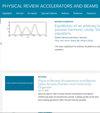加速器驱动亚临界系统10 MeV喷油器试验台物理设计
Physical Review Special Topics-accelerators and Beams
Pub Date : 2015-05-15
DOI:10.1103/PHYSREVSTAB.18.054201
引用次数: 7
摘要
高能物理研究所(IHEP)的10 MeV加速器驱动亚临界系统(ADS)喷射器I试验台是一个测试设施,专门用于演示两种喷射器设计方案之一[喷射器方案-I,工作频率为325 MHz],用于中国的ADS项目。喷油器由直线部分和光束倾卸线两部分组成。前者是在β = 0.12的325 MHz四叶片型铜结构射频四极和超导(SC)辐腔的基础上设计的。后者的设计目的是将光束从直线机的SC段传输到光束转储,其中光束横向轮廓相当大且不成形,以简化光束目标设计。SC部分由两个低温模块组成,共14个β = 0.12辐条腔,14个螺线管和14个bpm。物理设计中的第一个挑战来自于低温模块分离所需的必要空间,其中周期晶格以相对较低的能量(类似于5兆电子伏)被破坏。另一个挑战是束流倾卸线的设计,因为它将是世界上第一个使用阶跃场磁铁进行横向束流扩展和均匀性的束流倾卸线。本文概述了物理设计研究的概况,以及设计原则和机械结构考虑。给出了优化设计、制造状态和包括机器误差在内的端到端仿真结果。本文章由计算机程序翻译,如有差异,请以英文原文为准。
Physics design of a 10 MeV injector test stand for an accelerator-driven subcritical system
The 10 MeV accelerator-driven subcritical system (ADS) Injector I test stand at Institute of High Energy Physics (IHEP) is a testing facility dedicated to demonstrate one of the two injector design schemes [Injector Scheme-I, which works at 325 MHz], for the ADS project in China. The injector is composed of two parts, the linac part and the beam dump line. The former is designed on the basis of 325 MHz four-vane type copper structure radio frequency quadrupole and superconducting (SC) spoke cavities with beta = 0.12. The latter is designed to transport the beamcoming out of the SC section of the linac to the beam dump, where the beam transverse profile is fairly enlarged and unformed to simplify the beam target design. The SC section consists of two cryomodules with 14 beta = 0.12 Spoke cavities, 14 solenoid and 14 BPMs in total. The first challenge in the physics design comes from the necessary space required for the cryomodule separation where the periodical lattice is destroyed at a relatively lower energy of similar to 5 MeV. Another challenge is the beam dump line design, as it will be the first beam dump line being built by using a step field magnet for the transverse beam expansion and uniformity in the world. This paper gives an overview of the physics design study together with the design principles and machine construction considerations. The results of an optimized design, fabrication status and end to end simulations including machine errors are presented.
求助全文
通过发布文献求助,成功后即可免费获取论文全文。
去求助
来源期刊
自引率
0.00%
发文量
0
审稿时长
3-8 weeks
期刊介绍:
Physical Review Special Topics - Accelerators and Beams (PRST-AB), is a peer reviewed, purely electronic journal, distributed without charge to readers and funded by contributions from national laboratories. It covers the full range of accelerator science and technology: subsystem and component technologies, beam dynamics; accelerator applications; and design, operation, and improvement of accelerators used in science and industry. This includes accelerators for high-energy and nuclear physics, synchrotron radiation production, spallation neutron sources, medical therapy, and intense beam applications.

 求助内容:
求助内容: 应助结果提醒方式:
应助结果提醒方式:


